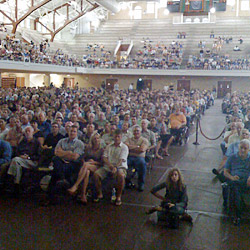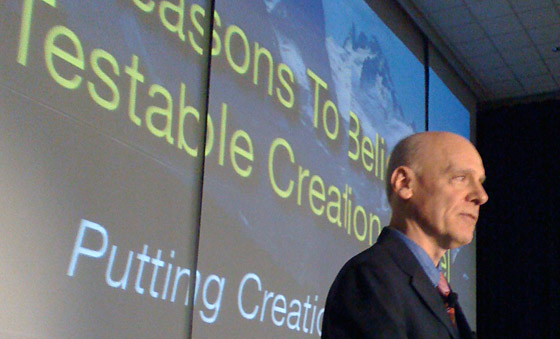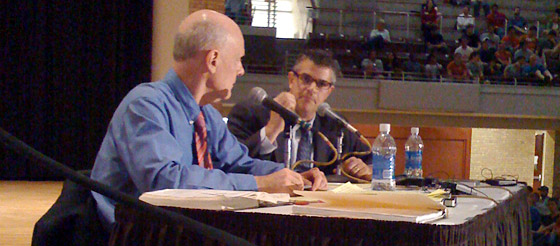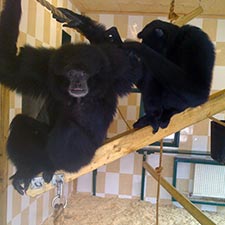Biblical Patternicity

Last night, April 28, 2009, I debated Hugh Ross and Fuz Rana from Reasons to Believe (RTB), an evangelical Christian organization whose mission it is to give people “reasons to believe” beyond the usual faith-based reasons. In this case, it is to scour the annals of scientific discovery in search of findings that seem to gel well with biblical passages; and even if they don’t seem to fit, these gentlemen are adroit at massaging both the research and the scriptures such that in the end they will fit come hell or high water.
I blogged about my previous debate with the RTB boys before, so I won’t repeat their arguments and my rebuttals here, but this was most definitely a larger venue and audience — the basketball arena at the University of Texas at Austin with over 3,000 in attendance — so I made sure that my presentation was especially poignant and lively (first and foremost, I believe, a public speaker must be interesting, have something to say, and say it in a manner that gets people to pay attention and remember). For example, I nailed Ross right off the bat on his claim that the RTB “day-age” model of creation is correct when he said that the use of the Hebrew word “yom” in Genesis means “epoch” (and therefore no matter what scientists discover about the age of the origins of life, the Earth, and the universe, they can say “see, our model predicted that correctly”).
No, sorry gentlemen, yom means “day,” as in, well, a day, a 24-hour day. Yom Kippur, for example, is the “Day of Atonement”. Yom Kippur is, in fact, the 10th and final day of the Ten Days of Repentance that begin with Rosh Hashanah. Yom Kippur does not mean the “Age of Atonement,” the “Epoch of Atonement,” the “Geological Age of Atonement,” or the “Cosmological Constant of Atonement.” As I pointed this out I could see Mssrs. Ross and Rana scrambling through their Bibles and other works of reference they had on the table with them, but they never did respond so I presume that they have conceded the point.

I also made the general point that their RTB creation models are based on postdictions, whereas science depends on prediction. That is, the RTB models start with what we already know about nature, then search for biblical passages to match them, then predict that we’ll find more of the same. This is exactly what the Nostradamians do, as when they “predicted” 9/11 … after it happened! Sorry gentlemen, that’s not a prediction; that’s a postdiction. For RTB to be science, they must make predictions about things we do not already know!
Ross claims that the Bible — and only the Bible — has a creation story to match that of modern cosmology; that is, the creation of the universe out of nothing, that the earth was without form and void, etc. That’s not true, and I provided several examples from the ancient Mesopotamians and the ancient Egyptians. But I also found this one that I added to the collection, from the Tao-te Ching 25, 6th century B.C.E.:
There was something undifferentiated
and yet complete,
which existed before heaven and earth.
Soundless and formless,
it depends on nothing and does not change.
It operates everywhere
and is free from danger.
It may be considered
the mother of the universe.
I do not know its name; I call it Tao.

At one point in my presentation I pointed out the supreme irony of an atheist having to explain to theists how to properly read the Bible. The book of Job, for example, is about suffering and the problem of evil and why bad things happen to good people. It is not a book of cosmology. Further, I noted that Bible scholars of all stripes (most of whom are deeply religious) agree that the Bible is an edited volume written by many authors over a long span of time. This helps explain why, for example, in one passage Noah is instructed to take two of every kind of animal on the Ark, and in another passage he is instructed to take 7 of each kind. One version has the flood lasting 40 days and 40 nights, another passage says 150 days. In one passage Noah sends out a raven to find land. In another passage he sends a dove. And on and on. By adopting the methods of Reasons to Believe, you are forced to dismiss all of this scholarship and miss the real meaning of the Bible. The Bible is about how people should get along with one another and about morality and ethics and meaning. By trying to make the Bible fit the current estimates of the Hubble constant (to pick just one among many examples), me thinks you are missing the point of the book, and thus (in your world view) you are missing God’s message.
Is that supreme irony, or what?
In a form of what I call “Literary Patternicity” (patternicity is the tendency to find meaningful patterns in meaningless noise), in the following passage from the great poet John Donne, it would appear that he anticipated the discovery of the double helix as the basis of life and reproduction:
Our eye-beams twisted, and did thread
Our eyes upon one double string;
So to intergraft our hands, as yet
Was all the means to make us one,
And pictures in our eyes to get
Was all our propagation.
Wow, incredible, how could John Donne have anticipated the discovery by Crick and Watson centuries later? But more importantly, my point in this exercise in literary patternicity is that you will miss the beauty and power of Donne’s poetry if you try to read into it modern scientific discoveries.
I closed with a set of challenges to Ross and Rana, asking them to tell us, from their scriptural readings, the answers to the following unknowns in science:
- Did Neanderthals have symbolic language, and what caused their extinction?
- Is RNA the precursor to DNA, and what came first, cells or self-replicating molecules?
- Did eukaryotic cells come from prokaryotic cells?
- When did ID/God intervene in the history of life — never, occasionally, always?
- Why doesn’t God heal amputees?
- If it turns out that your testable RTB models are refuted, will you give up your belief in Jesus as your savior?
Interestingly, although Ross said that if his RTB models were refuted he would give up his belief in both God and Jesus, there erupted in the audience a loud chorus of “no” voices, which made my point beautifully: this is not, never was, and never will be about science, because no scientific evidence would ever dissuade believers from their belief. Why? Because such beliefs are not based on science in the first place.
Q.E.D.


